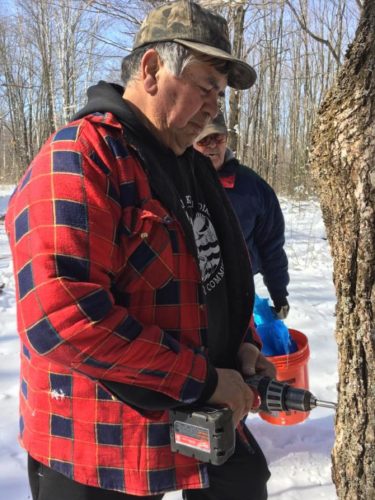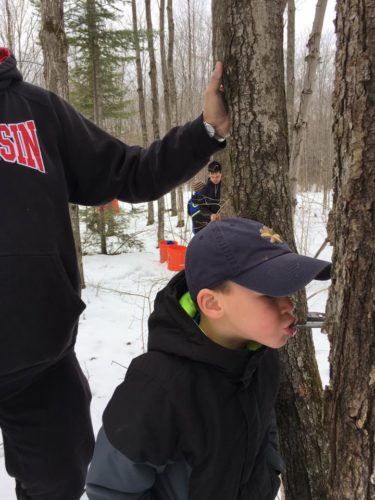It’s sugar bush time in Ojibwe country, which means my five-year-old cousin, Howie, is busy. He is the official taste tester at the Maday family sugar bush, or Iskigamizigan. Although his office is self-appointed, he takes his duties seriously.
“Yes, Howie has to taste the sap from every tree, and we tap about 200 maple trees,“ laughed Melvin Maday, Howie’s grandpa.
Melvin Maday drills a tap hole in a maple tree. It’s sugar bush season in Ojibwe territory.
Iskigamizigan time begins at the first signs of spring, when daytime temperatures rise above 32 degrees, allowing trees to generate the flow of sap. Maday and his family drill small holes about two inches deep into the trees and attach taps that allow the sap to flow into bags placed underneath. The sap is then boiled for several hours into syrup. According to Melvin, its takes about 50 gallons of sap to make one gallon of maple syrup.
The Madays, who live on the Bad River Ojibwe Reservation in Wisconsin, make 60 to 70 gallons of syrup per year. Iskigamizigan season lasts from four to six weeks, depending on the weather. Once the trees begin to bud, it’s time to stop tapping, according to Melvin, otherwise the resulting syrup will be bitter.
“Working the sugar bush is a little bit mysterious,” he said. “You have to work with Mother Nature. She is the boss who determines all the timing.”
Melvin also marveled at the resourcefulness of our Ojibwe ancestors.
“I wonder what first inspired those old Ojibwe people to boil the sap into syrup,” he said.
Iskigamizigan is a very old Ojibwe tradition and is typically an activity that involves the entire family. Before people had easy access to transportation, families would set up temporary camps near the sap collection sites in the forest and remain there collecting and boiling sap for the entire season. Melvin recalled that his and my parents lived through the Great Depression, when food and money were precious.
“That maple sugar was the only sugar they had back then,” he said.
In the old days, much of the sap was boiled down into sugar, or ziinzibaakwad, because sugar was lighter to transport and easier to use in cooking, according to Melvin. The sap was boiled down into ziinzibaakwad and pressed into chunks.
Melvin, 69, did not grow up working the annual Iskigamizigan. For his and my generation of Ojibwe, white sugar, cheap and easily available in stores, replaced ziinzibaakwad.
“Iskigamizigan is a lot of work, and our parents had no great initiative to go back to it,” Melvin said.
Ultimately, however, it was Melvin’s mother, Pat, my famous Auntie Pat, who brought him and the family back to the Iskigamizigan. After Pat passed on in 2011, Pierce, Melvin’s grandson, was concerned that the family seemed to be drifting apart. Indeed, Auntie Pat had been the emotional glue for our huge extended family, which spans many levels of cousins and cousins-in-law. Barely five feet tall, like my mother, she held court from her easy-chair throne. Her word carried weight and was heeded by all of us, even if we disagreed.
“Pierce wanted to do something to bring the family closer together and came up with the idea of Iskigamizigan, “ said Lynn, his mother.

Courtesy Lynn Bigboy
Howie Maday, 5 tastes the sap from a newly tapped maple tree during sugar bush season.
Lynn supported her then 11-year-old’s idea and encouraged him to reach out to family members for contributions to purchase some basic sugar bush equipment. With guidance from elders and friends in the tribe, Pierce hand-carved those first spigots from wood of the sumac tree.
“We made one gallon that first year,” Lynn recalled. “That was the best gallon we ever made.”
Every year since, the family has begun their work with a big feast and an offering of asemaa (tobacco) to the trees in gratitude for their sap.
“We have a core group of about eight people, but many more stop by and help for shorter periods,” Lynn said.
And of course, lots of people stop by to visit.
“There is a lot of healing in working the Iskigamizigan. It helps us understand that even though we may go through hard times, we can do it if we work together,” Lynn said. “Working the Iskigamizigan kind of slows everything down and connects you to the land and each other.”
For instance, the family has noticed that each year since beginning their Iskigamizigan, the season has started a bit earlier. Ojibwe, who observe a lunar calendar, call the moon phase in late April Iskigamizige-giizas, or Sugarbush Moon. Interestingly, the maple tree’s sap now begins to run nearly two moon phases earlier—a testament, according Bigboy of the reality of a changing climate.
There are only a few families on Bad River who do Iskigamizigan, but interest is growing among tribal members to revitalize the practice, according to Melvin.
“Iskigamizigan has become a little bit romanticized. The old timers talk about smelling the sweet fumes of the boiling sap and how good it made them feel as kids,” he said.
The Madays sell and give away about 75 percent of their syrup.
“We’re happy if we make enough to pay for the supplies,” Melvin noted. “We find that fifteen gallons is about enough for our family.”
Much of the syrup is given to tribal elders, who have deep attachment to the sweet treat. Bigboy noted that the little boys in the family are building that same affection for the work of the Iskigamizigan and the sweetness of the syrup.
“Today when we finished boiling, the kids came out with spoons. Once the spoons come out, everybody has to have a taste,” Melvin laughed.
“It makes for great family time. It’s kind of a spiritual thing and is so gratifying to see your grandkids begging to work in the Iskigamizigan,” he said.
Melvin paused and added, “The work and being together makes you feel good. It just feels like that’s what you’re supposed to do.”

Courtesy Lynn Bigboy
Ziinzibaakwad, or maple sugar candies made by Lynn Bigboy during sugar bush season.
© 2017 Indian Country Today Media Network, all rights reserved. https://indiancountrymedianetwork.com
https://indiancountrymedianetwork.com/news/environment/sugar-bush-time-ojibwe-country/
